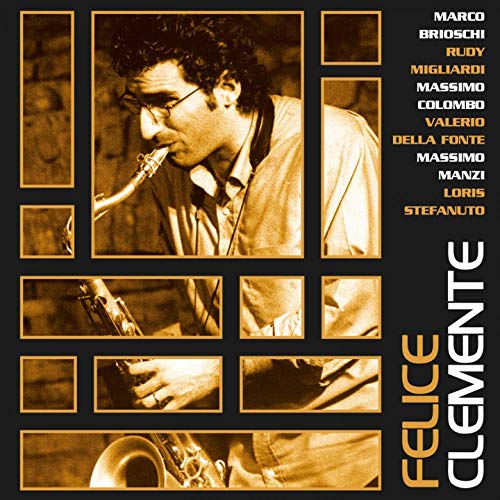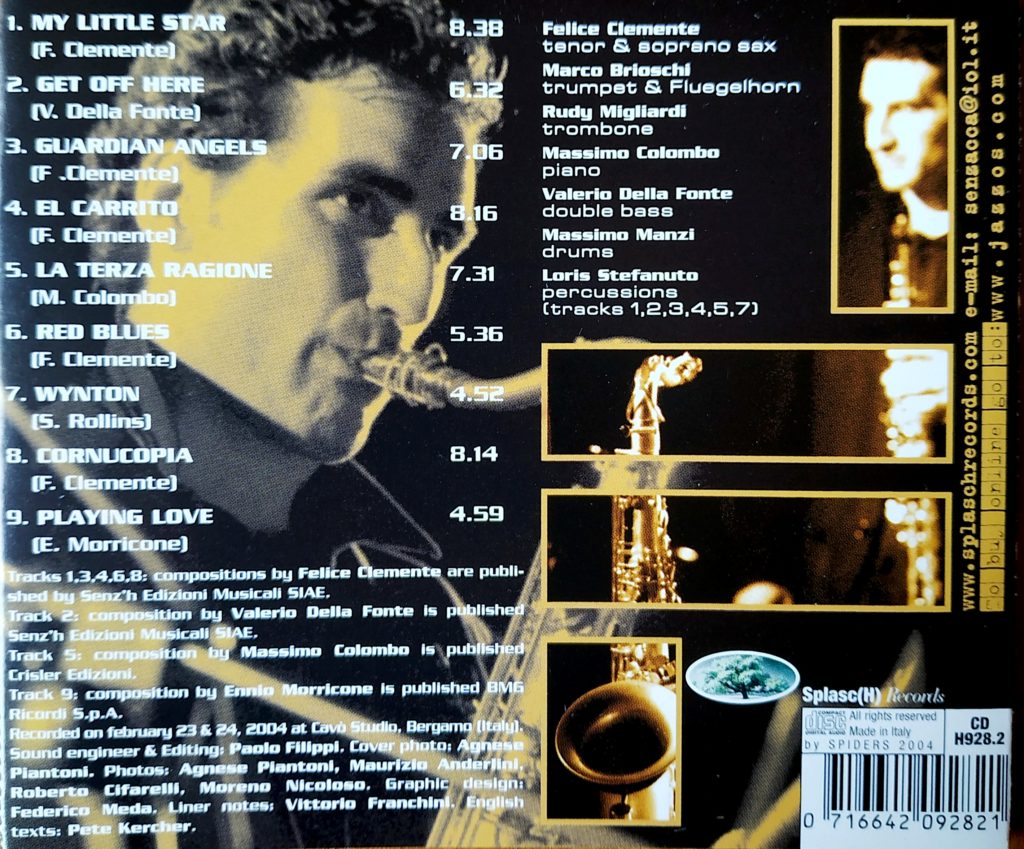2004

FELICE CLEMENTE | tenor and soprano saxophones
MARCO BRIOSCHI | trumpet and flugelhorn
RUDY MIGLIARDI | trombone
MASSIMO COLOMBO | piano
VALERIO DELLA FONTE | double-bass
MASSIMO MANZI | drums
LORIS STEFANUTO | percussions
As a second episode after “Way out south”, the Milanese saxophonist Felice Clemente releases his new work: “Inside me”, an introspective title that conveys all his love of jazz music, translated in all of the rhythmic facets of latin, blues, swing and afro, the timbre components of the ensemble of a larger horns and rhythmic instruments section, the overlap between a full, rich sound and a more intimate approach. The group of musicians who play with Clemente, selected because of their musical and personal affinity, play the tracks with an unusual and original formal harmonic structure, highlighting the qualities of the soloists and of the ensemble at the same time, boosting their very unique personalities and impact strength. In addition to the 5 pieces written by Clemente himself, one by Della Fonte and one by Colombo, “Inside Me” includes Wynton, by Sonny Rollins, and Playing love by Ennio Morricone, from the movie The Legend of the Pianist on the Ocean, as a special tribute to these legendary contemporary musicians.

LINER NOTES FOR THE ALBUM “INSIDE ME”
By Vittorio Franchini
There is a kind of music that, somewhat unconsciously, seems to have been created to build bridges, to ease the way towards understanding, to tap into tradition and project it into the near future. It seems to me this is the case of “Inside me”, a charming project by Felice Clemente who, through this record, seems to be wanting to encapsulate the history of jazz, travel across it, shed light on some of its pages and then dissolve it in other dimensions.
Felice Clemente is an excellent instrumentalist. His most remarkable skill is to be able to forget his technique, in favour of the dynamics of feelings. You can immediately feel this when you listen to his long solos, from which another question emerges, that of the relationship between written and instant composition. Through the breath of his instrument, you can sense the moment in which the musician detaches himself from the basic idea of climbing the heights of the different, delving deep into the abyss of silence, then finding the right foothold that allows to continue the climb. Together with him, his excellent fellow adventurers are focused on preserving the formal aspect of the composition, and yet they all eventually come to surrender to that transgressive flair that takes refuge in the mystery of improvisation, eventually finding solid support in the rhythmic section, led by Massimo Colombo and aided by the subtle inventions of Manzi, Stefanuto, Della Fonte, a section capable of making the whole structure stable while taking risks, embarking on paths that are not parallel at all, as they interplay with the soloists, providing a stronger support to the musical colours.
One of the greatest names in jazz music, Gill Evans, if I’m not mistaken, once said that, having very little memory, he was forced to improvise. This was a joke, of course, because, quite on the contrary, as nothing comes out of nothing, improvisation – which is evident in how Clemente, Migliardi and Brioschi are “singing away”- feeds on the past, digests it and polishes it off. Rather than being only the product of a more or less active repetition of a typical phrase of this or that maestro, improvisation recreates the atmosphere, the lyrical core, the intention that, in a moment, and in that precise moment only, may only arise along the common thread of personal poetics.
Finally, a remark about the compositions: except for a theme by Rollins and another one by Morricone, all the compositions are written by Clemente, Colombo and Della Fonte, creative musicians gifted with strong, individual personalities. Yet, when you listen to the album, their different way of writing suddenly becomes a single discourse, a common language, almost as if the melodic cells, even though they are different, manage to coalesce through the many good vibrations of the orchestral mix, creating a compact, fluid whole that reveals the effort of putting the parts together, with the result of bringing composition and improvisation together, both perfectly integrated in a sort of “happy”, (pardon my reference to Felice – Felice in Italian means happy) and spontaneous research.